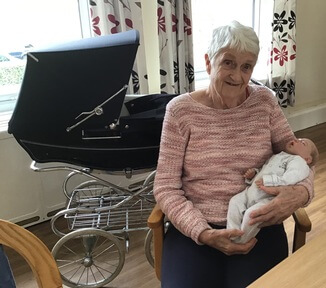
Doll therapy is becoming increasingly common in care homes all over the world. As with pet therapy, specially-made dementia dolls can provide people with dementia with something to love and care for. The dolls can trigger innate or remembered nurturing instincts in a person with dementia which can, in turn, have powerful effects on their wellbeing as they form an emotional bond with the doll.
Not everybody agrees with doll therapy, due to concerns that a person with dementia may confuse the doll for their own child or that it may cause unnecessary stress if they believe the baby is real. It can be hard for families to see their grandma cuddling a doll and there are worries the person being given the doll is being infantilised. Whether dementia dolls are beneficial depends very much on the individual, and steps can be taken to gently ease the doll away if it is having negative effects.
What are dementia dolls?
Dementia dolls, sometimes called therapy dolls, are life-size dolls that are made to mimic a very small child or baby.
They come in different ethnicities and have detachable clothes. There are different styles available, including:
Fabric dolls
These are styled like rag dolls, with unrealistic features to avoid confusion with a real baby and made in bright, cheerful and dementia-friendly colours. These are lightweight and easy to carry for people who may be frail or have limited mobility. They are machine-washable and some have pockets in which scents such as lavender or cinnamon sticks can be stuffed to add an extra sensory factor that can be comforting and trigger memories.
Plastic dolls
These look similar to children’s baby dolls and are easy for people to cradle in their arms or move their limbs. They usually have their eyes open to promote eye contact, but some have eyelids that can be opened and closed. Being plastic makes them easy to clean and they are a good option for people who want to fully take care of their doll, including bathing it and changing its nappy.
Lifelike dolls
Lifelike dolls are more expensive but have features that make them look and feel like a real baby. They are made of material that is designed to feel like real skin and they have realistic hair, nails and eyelashes. They are heavier than other dolls, around 3-6 pounds, and some are even able to ‘breathe’. People with dementia are more likely to engage with lifelike dolls but they may also be a source of confusion.
Babyloids
These Japanese dolls are the most unrealistic to look at of all dementia dolls but also the most technologically advanced. They look like a furry pillow with a dinner plate stuck on but they have remarkable features including over 100 realistic sound effects, LED tears, the ability to blush and to give positive feedback when cared for. These are still being developed and not currently available in the UK, but when they do hit the market they could cost over £17,000 each.
What are the benefits of using dementia dolls?
Doll therapy has been proven in many cases to provide the following benefits:
- A calming and soothing effect that reduces stress and anxiety.
- Improved mental clarity and memory as the task of caring for a baby is familiar to them and can stimulate the brain.
- Improved mood and a reduction in aggressive behaviours.
- Increased self-confidence and sense of purpose.
- Decreased loneliness.
- A study published in the International Journal of Applied Scientific Study found that dementia dolls can be ‘transitional objects’ during times of change. This means they can be used as a crutch for people when a potentially stressful change is occurring, for example, they are moving to a new care home, acting as a constant while they get used to their different routine or environment. It can also apply to the change of growing older and living with dementia as they are able to re-enact a parental role that they are already comfortable with.
How to get a dementia doll for your loved one
If you are interested in buying a dementia doll for your loved one, it is important to include them in the process if possible. Try to let them choose the gender of their doll, what it looks like and what type of doll they want. The dolls are sold almost exclusively online, but you could try inviting them to hold a child’s toy baby in a high street shop to see how they react to it.
Once their new doll arrives, it’s important not to present the doll as something they need to care for. Even if they chose the doll, make sure to allow them to choose to care for it. This could be by leaving it somewhere they’ll find it (not an intrusive place like their bed).
If your loved one does become attached to their doll, make sure to treat it the same way they do. This could be calling it by the name they’ve chosen, asking how it is and following any childcare rules they’ve decided on.
If your loved one doesn’t respond to their doll or actively dislikes it despite a few tries, you can gently remove it. Never throw it away in front of them or get angry that they didn’t use it. Instead, try talking to them about whether they would like somebody else to look after it or gradually reduce how often it is somewhere they can see it.
You can read about other dementia therapies being used in care homes here.
Find your ideal care home
- Explore a wide range of care options and facilities
- Read independent ratings and reviews
- Connect directly with care homes to book a tour and discuss your needs


